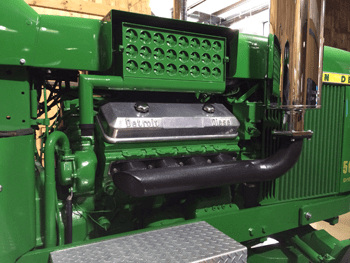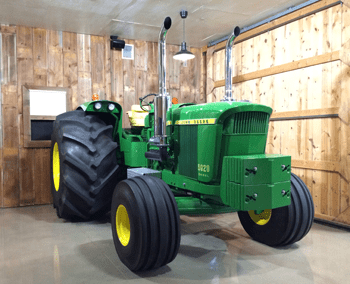In 1965, John Deere introduced the 5020 standard, regarded at the time as one of the more powerful two-wheel-drive models on the market. A row crop version would be introduced the following year. Then, in 1968, the 5020 received a serious power increase to 141 hp – putting it near the forefront of the industry.

Within a year or so, a farmer from Reinbeck, Iowa by the name of David Bystriki approached Jon Kinzenbaw at his Ladora shop to see if the young welder could find a way to fit a Detroit 8V-71 engine in the 5020 – which would boost its power tremendously to approximately 320 hp. At the time, the term “re-power” wasn’t even part of the farmer’s vocabulary – but it would be soon thanks to Jon.
The Detroit 8V-71 was almost literally an ideal fit for the 5020. Whereas an oversized engine would have required stretching the hood and frame, the 8V-71 could slide into the original engine compartment and fit into the tractor with only a few key modifications.
That’s what brought Bystriki to Ladora, Iowa. Only three short years after opening his small welding shop, Jon had already forged a solid reputation for being able to complete tough modification jobs. With a skilled hand, a sharp mind, and the courage to take on any challenge – Jon tackled the project.
“It’s one thing to re-power things that are easy to do, but John Deere had a specific bolt pattern on the bellhousing and a lot of things that really made it difficult for the average re-power,” said Jon, who estimates that he’s rebuilt nearly 200 John Deere 5020s.
After taking the tractor apart and modifying several components, Jon was able to complete the re-powering without having to stretch the hood or the frame, which would have been extremely costly and labor-intensive. All things considered, it was a clean installation. For a full account of the re-powering, check out this Heritage Iron article from spring of 2012.

But why re-power the 5020 in the first place? According to Jon, the John Deere 5020 had limited horsepower by design, with the thinking behind it being that excess power would pull the plow out of the ground. Hundreds of farmers at the 1971 Farm Progress Show observed otherwise.
That year Jon arrived at the show with a re-powered John Deere 5020 and an adjustable-width 7-bottom plow that he’d designed. Some would say it went pretty well. “The demonstration with that 5020 is what started to put Kinze on the map,” Jon said.
Over the next few years, Kinze performed re-powers of John Deere 5020, 4020 and 4520 tractors for farmers across America – from New York to California and Canada down to Texas. As a result, Kinze developed a solid base of customers, which helped drive sales when it introduced its grain carts in 1971 and planters in 1975.
Jon’s John Deere 5020 is the very same one he took to the 1971 Farm Progress Show (which he sold a year later and bought back in the early 1990s). It’s an important piece of the company’s history and we welcome you to visit the Kinze Innovation Center to see it in person. After all, as Jon said, it helped put Kinze on the map.
